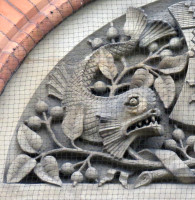
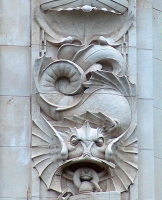
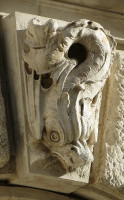
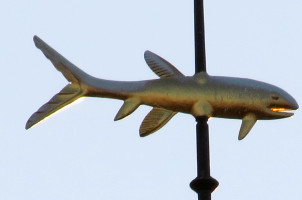
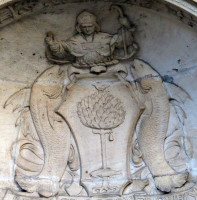
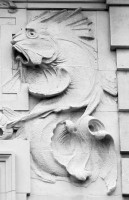
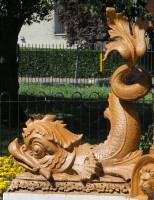
The British nautical and naval heritage makes for much architectural sculpture associated with the sea, so fishes are a natural part, along with sculptures of shells, reliefs of ships, the occasional statue of a crustacean, and the innumerable keystone heads depicting sea and river-gods.
Classical fish sculptures often mistaken for dolphins. 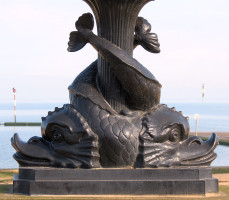
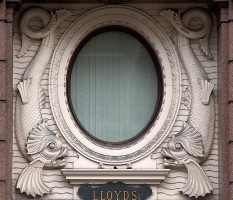
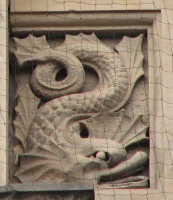
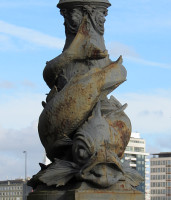
The Victorians and Edwardians made large numbers of sculptures of fishes. The most common single type, though, is often mistaken for a dolphin. The ancient Classical dolphin, taken as a model and inspiration for countless artworks ever since, has a recognisably delphinic body, sleek and pear shaped, but a very short, flat beak compared to real dolphins. So when we see sculptures such as these above, with this sort of round head and stretched mouth, it is easy to think of them as dolphin statues. But the tails are horizontal, the fins spiny rather than what should be smooth flippers to the sides, the bodies scaly, so these would seem to be intended as true fishes, not dolphins – sturgeons have been suggested.
Here are some examples of long-tailed fishes, rather similar in body to the near-dolphins, and with or without the 'beaks'. The left and centre ones have bony heads, the second and fourth show the not uncommon case of a grotesqued fish, which is to say one where the shape is distorted to emphasise the decorative over the naturalistic elements. To the right are an interesting pair, the one in front with a clear beak, and some sort of fishy moustache, it seems, and the one in the rear with a head reminiscent of a pike.
'Standard' fish carved in low relief. 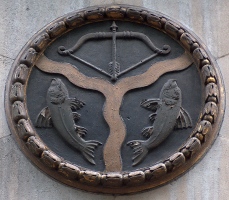
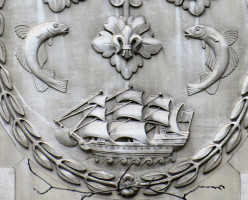
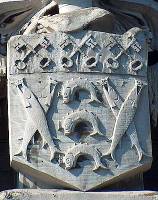
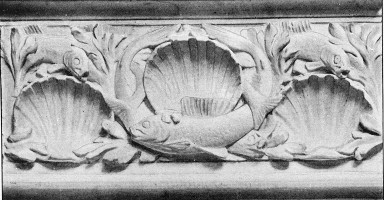
The ‘Normal’ or standard fish shape found with perch, salmon and their cousins, adapts well to low and high relief sculpture. Also, being so easily recognisable, the shape is good for the smallest scale work, such as part of a heraldic device on a shield. Unhappily for them, these standard fishes are the most often type chosen when dead fishes are called for. Thus the fisherman’s haul, the sculptural equivalent of the dead game group of Snyders’ paintings, or the hapless prey of some aggressive animal eating a fish.
Relief sculpture showing fishes being eaten, or as game. 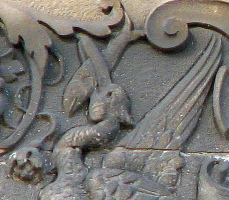
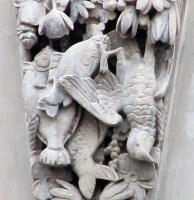
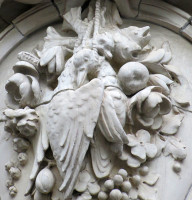
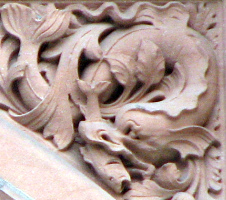
Here are examples of shark sculpture: Art Deco sculpture by William McMillan, from the well known groups in the fountains in Trafalgar Square, and utterly appealing. Equally appealing is the seahorse below right, in cast iron.
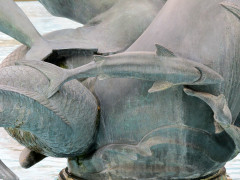
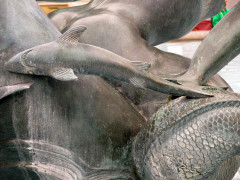
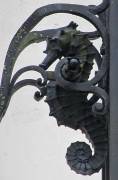 Small shark sculptures in Trafalgar Square, and cast iron seahorse.
Small shark sculptures in Trafalgar Square, and cast iron seahorse.
Fish sculptures appeal to the sculptor and designer on practical grounds because their variety makes them suitable for a variety of decorative needs in architectural sculpture. This is especially true for the long-tailed varieties, and eels, as in the examples below. To the left, a curled eel makes a composition nicely filling a panel, in the centre is what is intended for a snake, but which has a body clearly modelled on a Congar eel, and to the right, a similar beast has coiled its body around an anchor; the tail at the top is from some other beast.
The Eel in decorative sculpture. 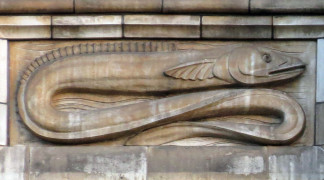
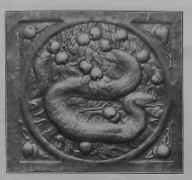
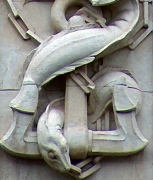
Flying fish were interesting, exotic creatures to the Victorians, as shown in the engraving below left, which shows a shoal of them leaping out of the water to escape dolphins, and being attacked by birds (you will need to click to enlarge to see this properly). In sculpture, flying fish are really rather rare, and I could think of only two examples: the spectacular fishy surround to a keystone, below centre, emphasising the mystery of the oriental face, and the modern fish weathervane below right.
19th Century engraving and two sculptures showing flying fish. 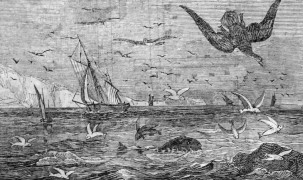
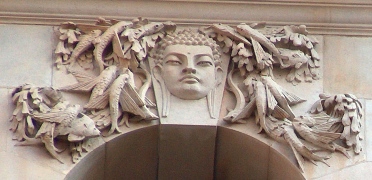
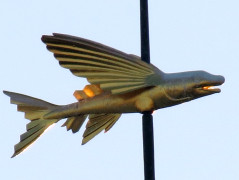
Keystone heads bring us on to a broader opportunity for use of fishes in decorative sculpture. The gods of river and sea are frequently found as keystones (see the page on bearded keystone heads). A feature of such things is for the sculptor to carve accoutrements in the hair and beards of the personages, and what could be more suitable in this respect then a delicately carved fish or two? The examples here show several variations on this excellent theme - you may need to click to enlarge to see the fishes.
Bearded keystone heads with fishes carved in their hair. 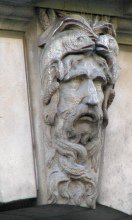
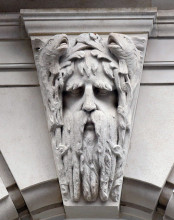
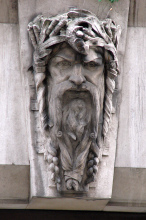
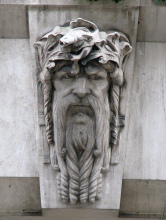
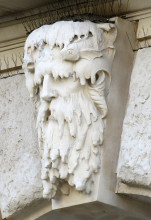
On to full sized statues of gods and goddesses, and here there is a tradition of heaping up emblems of the sea in an encrusted pile of seaweed, anchors, treasure, shells, and, of course, fish. The examples below show the rear of a merman grasping a long, gasping fish, with a nice comparison between fishy and human muscularity. This is from the Victoria Rooms Fountain, in Bristol. The two stone examples of heaped treasures of the sea, with fish, are from Cardiff City Hall - all three examples are by the sculptor P. F. Poole.
Fishes as part of large sculptural groups. 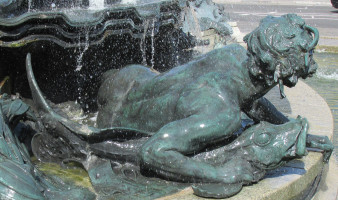
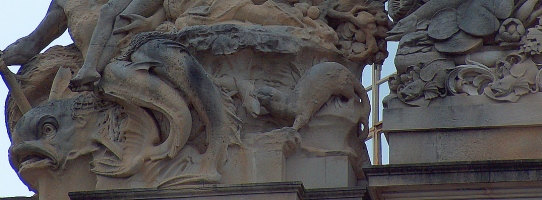
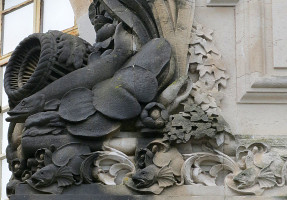
This last group above comes form a Renaissance tradition, the key stone heads of sea gods and river deities are mostly from Pagan and Celtic origns, and we mentioned the Classical tradition of dolphins and sturgeons. But from medieval times, surely it is the inspiration of Hieronymous Bosch which gives us the grotesque fish monster - see example at the top of this page, far left.
We have not covered fishing as an industry yet, and there are various examples of statues and sculpture showing fishermen and women, and groups at work on the catch. Below left is Mary Thornycroft's study of Prince Leopold as a boy fishing. Then three groups from the Manchester Fish Market, extremely competent sculpture by the obscure sculptor Henry Bonehill. Then a standing fisherwoman, in the style of the worker as a heroic figure which became rather popular in French art early in the 20th Century. And to the right, a study of the male nude as two fishermen hauling in their catch.
Sculptures showing people fishing, and dealing with the catch. 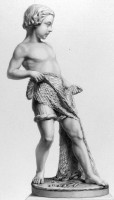
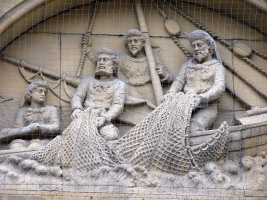
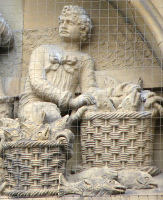
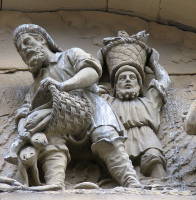

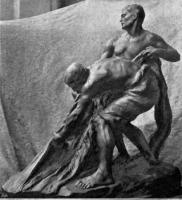
Fishing can also be treated as allegory, thus a statue of a nude as the epitomy of the fisher, and below are three examples. To the left, a statuesque, rather Renaissance type of girl holds a large fish against her side; in the centre, a fisherman has been caught by some nymph of the sea in an embrace which may lead to his watery doom, or not; and to the right, a charming study of a girl fishing with a line - her proportions are of an ideal Edwardian type of nude.
Allegorical figures of fishing. 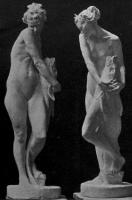
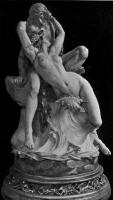

Finally, we return to the calm, classical tradition for the half-fish, half animal or half human combination. The lover of sculpture generally welcomes enthusiastically the mermaid, a statue half fish, half girl, subject of a separate page, as is her mate, the merman or triton. Half fish half horse gives us the sculpture of a heraldic sea horse or hippogriff, not so common, and with an antlered deer, the sea stag, rather rare. Oddest of all is the sea-centaur girl, pictured far right below. Three cheers for them all.
Other part-fish sculpture: mermaid, triton, hippogriff, sea stag, and sea-centauress.
Visits to this page from 7 Dec 2014: 22,543
Turtle sculpture // Animal sculpture // Mermaid statues // Mermen statues // Ship sculpture